Third Text
- Thinking Gaza: Critical Interventions
- Living Archives
- Decolonial Imaginaire
- Decolonising Colour?
- Mohini Chandra, DAY OF SHADOWS, 2020
- BOOK REVIEW: Nicholas Gaskill, ‘Chromographia: American Literature and the Modernization of Color’ (Kirsty Sinclair Dootson)
- Ben Pollitt, ‘The Blue Beyond: Naiza Khan’s Manora and 'The Left-to-Die-Boat'’
- Natasha Eaton, ‘Sepia, Camouflage, Modernity’
- Rebecca M Brown, ‘The Gold, the Gold; the Glory, the Glory: Overcome by Colour in the 1870s and the 1980s’
- Malevich’s Black Square under X-ray: A dialogue on race, revolution and art history – Khadija von Zinnenberg Carroll and Dina Gusejnova in conversation
- Rangituhia Hollis: Notes on Colour
- Jagjeet Lally, ‘Colour as Commodity: Colonialism and the Sensory Worlds of South Asia’
- Natasha Eaton, ‘Anechoic White? Meta-colour in South Asia’
- Carolyn L Kane, ‘From Black to Gold and Back - Strategies of Being in Kevin Amato’s Bronx Aesthetic’
- Ralph Paine, ‘The Time of Times That is a Rainbow - Notes on 'Emotional Geographic'’
- David Batchelor, ‘Colour...’
- Tessa Laird, ‘Dy(e)ing is Not-Dying: Nova Paul’s Experimental Colour Film Polemic’
- Justin Coombes, ‘Colour and Expanded Rhyme: Some Reflections on 'Reversed Curses'’
- ‘Artist and Empire’ Part 2: Singapore (2016–2017)
- ‘Artist and Empire’ Part 1: Tate Britain, London (2015–2016)
The Time of Times That is a Rainbow - Notes on 'Emotional Geographic'
Ralph Paine
Delight is in the flight –
Or in the Ratio of it,
As the Schools would say –
The Rainbow’s way
- Emily Dickinson
On Abraham’s forgotten path, America’s path of forgetting…
In the dark of the night before the morning of 11 September 2001, while mistaking the electric lights on inside the buildings for guiding stars, ten, twenty, perhaps thirty migrating birds would have flown headlong into the immense glass walls of Manhattan’s Twin Towers, many plunging to their deaths on the pavements below. At dawn on 11 September 2001, hundreds of believers throughout the eastern seaboard of the United States would have recited these words: ‘God is the light of the heavens and the earth... Light upon light; God guides to His light whom He will.’1 Before takeoff on board the four fateful flights of that day, crew members of the aircraft would have received information from traffic control stating that atmospheric conditions for the morning would be extreme clear.
It is said that the world is composed of fire, a circle of fire; that a karmic wheel turns in cruel rotations of everlasting sacrifice, like a serpent eating its own tail; that we dwell in eternal cycles of birth, death and rebirth; that time is corruption, an infinite accumulation of debt and guilt upon which only an elite few may feed, blissfully, in boundless wealth and luxury. Ash and fire, fire and ash… So much is warranted thus, forcefully imposed by such beliefs, from caste systems and traffic in slavery and servitude to the pitiless cycles of political economy wherein the destructive powers of war and terror feed the creative industries of peace and security. Profits rise, always from Ground Zero.
For a long time I used to get cluster headaches, a rare and acute type of migraine aka suicide headaches. Indeed, pain scale-wise cluster headaches are considered to be way up there, akin to kidney stones and difficult child birth, but different of course, and in my case often accompanied by visual fraying, sparkles and wrinkles, heightened colour perception, and brief-all-too-brief episodes of intense euphoria.
During the morning of the southern summer solstice, 2001, I started in on a real bad cluster of cluster headaches, waking at dawn that day with devastating one-sided head pain, as if an ice pick were being driven from the top of my skull down and out through the right eye socket. A crazy ordeal lasting hours on end, abating and returning, to be repeated the next day, and the next, for five tortuously long weeks. Early on in the cluster I began drawing coloured-pencil rainbows, lots of them, obsessive-compulsively on random scraps of paper. A distraction perhaps, attempted remedy, therapy, documentation – who knows? Loaded up on somewhat ineffectual combos of caffeine and Ibuprofen, a forced daily schedule in the studio quickly developed, performed between long, anxiety-ridden walks and the nastiest periods of bedridden pain, with additional drawings and initial watercolour experiments soon piling up, pinned up, accompanied by scribbled lists of sayings and esoteric statements, and then suddenly the idea of completing a series named Emotional Geographic struck home.
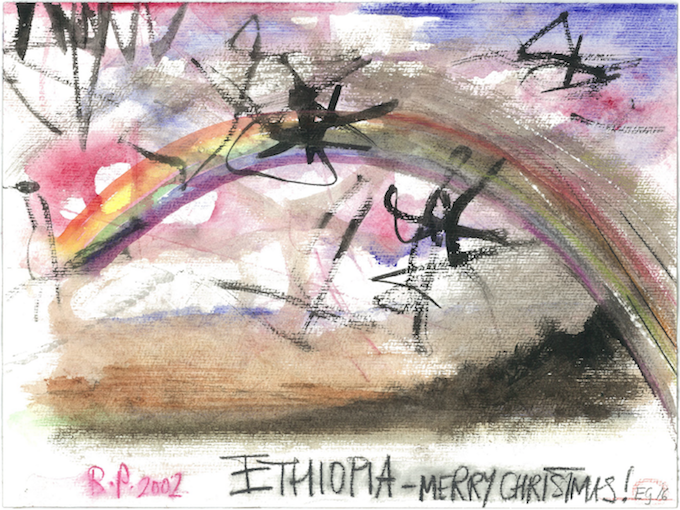
Ralph Paine, Ethiopia—Merry Christmas! – Emotional Geographic 16, 2002. 240 x 320 mm, gouache, watercolour and coloured pencil on paper
Éric Alliez:
Vision unexpectedly realises an ‘irreal’ in which we are confronted with the gestation of our own gaze, revealing itself to us like the dimension of an unknown genesis that moves us. For what can we say of so-called ‘persistent’ images… if not that such images are as one with the retina, that they contract upon its surface, from which they will inevitably inherit a particular geography?2
The etymology of the word migraine tracks back via Old English and Latin to the Ancient Greek hemikrania, a compound of hemi = half and kranion = skull. The symbolic transformation for Emotional Geographic is thus from the half-skull of migraine to the half-circle of a rainbow. Alchemy – THE GOLD–SHIT PROBLEM.
McKenzie Wark:
Diffraction is only partly about the passing of a form from one domain into another. It is also the testing of the pattern of the transposition. Descriptions of nature are always caught up in substitutions, but there might be a way to work it so that assumptions from the dominant organisational forms are filtered out a bit, and some patterns from the labour of working in and against apparently natural materials come more to the fore. It’s a practice of diffracting one body – or are they waves? – of knowledge through another.3
ADAM, EVE & THE SERPENT – in the beginning, diffraction.
There’s Palestine, Aotearoa, Australia, Polish grasslands, a coastal scene, rift valley, places of war, famine, drought: the desert grows. And yet… Rainbows in the desert? Hope? Rainbow = Queer Theory? A ‘new architecture’ of the Earth à la D H Lawrence? Rainbow Serpent? Rainbow Warrior? Yes! But such clichés! Perhaps only confronted and then counter-effectuated here as irony, bitter humour, bitter tears – HAPPY EASTER AMERIKA! ETHIOPIA MERRY CHRISTMAS! SOMALIA HAPPY NEW YEAR!
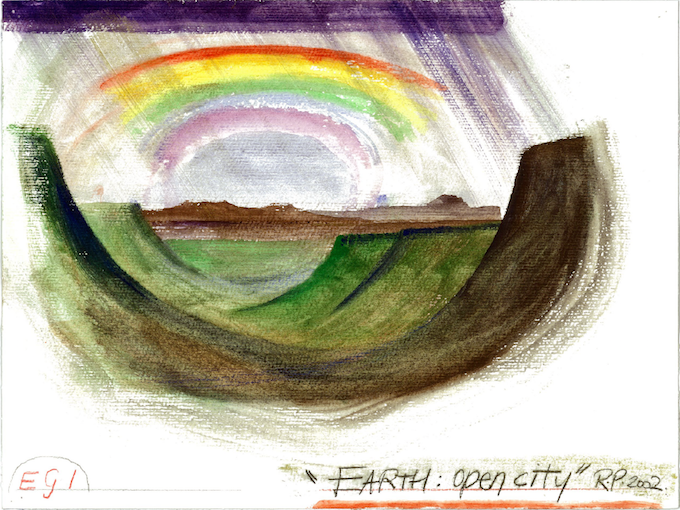
Ralph Paine, Earth: Open City – Emotional Geographic 1, 2002. 240 x 320 mm, gouache, watercolour and coloured pencil on paper
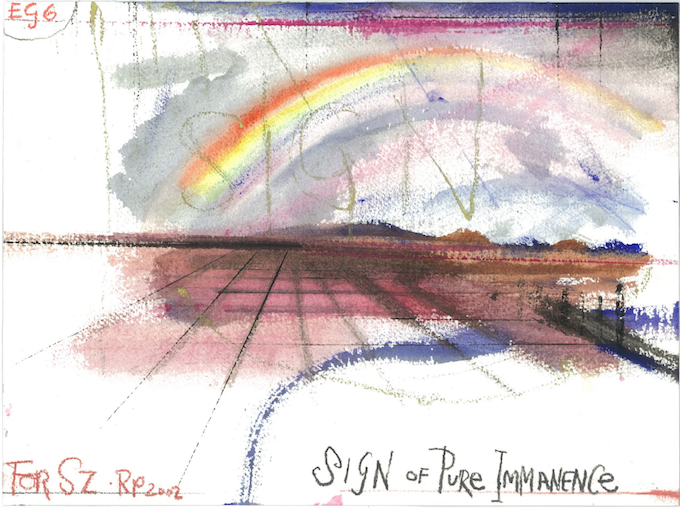
Ralph Paine, Sign of Pure Immanence: For SZ – Emotional Geographic 6, 2002. 240 x 320 mm, gouache, watercolour and coloured pencil on paper
First exhibited at Arch Hill Gallery in Auckland in 2003, as part of the anti-patriotic Cuckoo curated exhibition Put Out More Flags, my watercolour rainbows re-place NATIONAL with EMOTIONAL. Here’s the question: how to think and feel outside the ideology of the politico-cultural entity named the nation? Along this problematic line – and primarily by means of the scrawled titles, sayings, and statements – the series hints at resistance and flight. To think and feel otherwise than the ways of the nation (and its force of Law) is the emotional concern of an indeterminate collective, a people = X. Not ‘We, the People’ because they are a collective always already bound by the determined and determining identity of a nation. Emotional Geographic is literally empty of people. These are landscapes of ‘too few lovers’ (McCahon). The people are missing. In a late essay on cinema Gilles Deleuze wrote that if art is at all political it is so only in the way it summons forth a people to-come: ‘un peuple à venir’.4
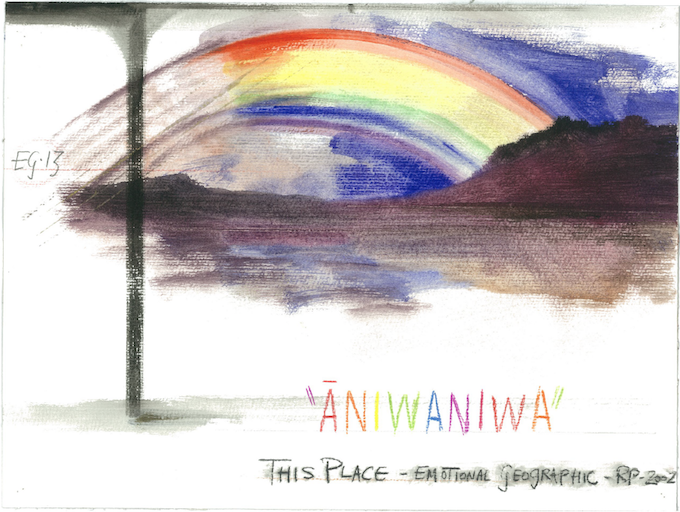
Ralph Paine, Āniwaniwa: This Place – Emotional Geographic 13, 2002. 240 x 320 mm, gouache, watercolour and coloured pencil on paper
DIS-SHELTERING: SAINT AUGUSTINE’S MIGRAINE – towards the city of God on Earth. EARTH: OPEN CITY – towards the ‘rainbowed city of Time’ (Negri). An allegorical city? Yes, because in allegory, as Deleuze conceives it, the logical relation of a concept to its object is ‘surpassed’. In allegory objects overflow their borders, entering cycles and series and thus taking on ‘natural relations’; while concepts become ‘compressed, interiorised’ in a manner ‘that can ultimately be called personal’. Hence, the object that is the open, rainbowed city of Time overflows itself, is in excess of itself, in excess of the persons who compose it. Fecund, dialogical, swarming, polyglot, hydra-headed, contagious… The city reveals – will reveal – a natural history ‘that no longer has its centre’. Or, being nowhere in particular, its centre is extended, spread out, vaporised, and endlessly dispersed. And this would mean that the personal – that is to say, the here and nows of the city’s subjectivity – will be nothing if not the (re-)conceptualised ‘ownership’ of the city, an interior space of ‘belonging-to’ and co-operation where the disparate All is compressed – is compressing itself – into an allegorical unity.5
Ki te koma te aniwaniwa, ka mate te iangata – If the rainbow is of a pale hue, the multitude will perish.6 UNITED NATIONS MULTITUDO.
To speak as the artist is one thing, but these completed works – or better, abandoned works – cannot represent me, nor I them. The eighteen signatures thus mark a sovereign absence, appear as rapidly executed signs of my departure from the scene, a departure making holes in the world, portals, striped paths, possible escape routes. The series is fabulation, potentiality, ‘whatever-being’ (Agamben). Yet this indeterminacy only on proviso that to experience the multicoloured images is to experience compositions of an entirely singular nature, and thus ones both true to themselves and to the time of times that is a rainbow within which they subsist.
In the end I managed eighteen finished paintings, and by then the headaches had completely disappeared, suddenly returning to the deepest waters of the deepest lake on the planet whence I imagined they came. Perhaps the last one or two were painted while cluster-free. I remember some months after completion randomly numbering the series – EG 1, EG 2, EG 3, etc – so the sequencing is non-chronological, each rainbow simply an example, cluster within a cluster – SIGN OF PURE IMMANENCE.
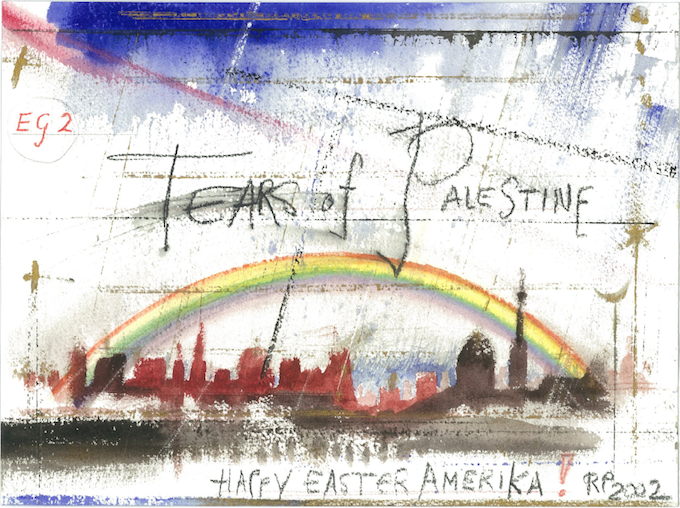
Ralph Paine, Tears of Palestine: Happy Easter Amerika! – Emotional Geographic 2, 2002. 240 x 320 mm, gouache, watercolour and coloured pencil on paper

Ralph Paine, Dis-sheltering: St Augustine’s Migraine – Emotional Geographic 4, 2002. 240 x 320 mm, gouache, watercolour and coloured pencil on paper
1 The Koran, N J Dawood, trans, Penguin Books, London and New York, 2003, p 249
2 Éric Alliez, The Brain-Eye: New Histories of Modern Painting, with collaboration from Jean-Clet Martin, Robin Mackay, trans, Rowman & Littlefield International, London and New York, 2016, p 17. Emphasis in the original.
3 McKenzie Wark, Molecular Red: Theory for the Anthropocene, Verso, London and New York, 2015, p 155
4 Gilles Deleuze, ‘Having an Idea in Cinema’, in Eleanor Kaufman and Kevin Jon Heller, eds, Deleuze and Guattari: New Mappings in Politics, Philosophy, and Culture, University of Minnesota Press, Minneapolis and London, 1998
5 Gilles Deleuze, The Fold: Leibniz and the Baroque, Tom Conley, trans, University of Minnesota Press, Minneapolis and London, 1993, p 125
6 Pēpeha or Māori saying as cited in Elsdon Best, ‘Rainbow’, in The Astronomical Knowledge of the Māori, Genuine and Empirical. Available at http://nzetc.victoria.ac.nz/tm/scholarly/tei-BesAstro-t1-body-d1-d10.html, accessed 4 October 2016, translation modified
Ralph Paine is an artist currently living in Aotearoa/New Zealand. Recent exhibitions include Errantries, Window Onsite, University of Auckland, 2013; Ltd, Snake Pit, Auckland, 2012; and In the Hills Near Fabriano, Gambia Castle, Auckland, 2010. He writes occasional articles for EyeContact, a website commenting on contemporary art in Aotearoa/New Zealand.